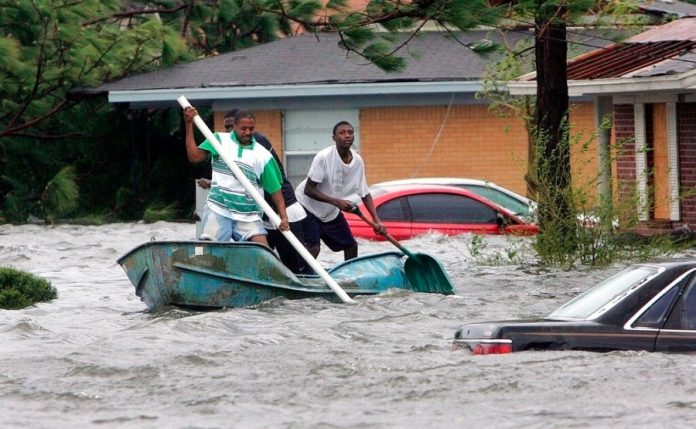
Twenty years after Hurricane Katrina, the U.S. enters another dangerous season with a fractured national emergency response system. Katrina showed what happens when truth and trusted communication are missing. Those lessons are now in danger of being lost.
The Gulf of Mexico is nearly two degrees warmer than normal. The Atlantic is very active. Floods are striking communities across the country, and wildfires are burning in the West. The National Oceanic and Atmospheric Administration forecasts an above-normal number of storms as we move into the most dangerous stretch of hurricane season.
And when we should be at our best, federal systems for delivering life-saving information are at their weakest in years.
When disaster strikes, one of the most critical lifelines is not food or water. It is information. People need to know what is happening, why it matters, who has answers, and what comes next. They need honest updates, a clear plan and credible voices — not spin, not confusion, but just the truth, especially when it is difficult.
Help only works when people trust it. After Winter Storm Uri in 2021, multiple reviews found serious communication gaps in Texas. When local messages were delayed, vague, or not translated into locally spoken languages, trust collapsed, no matter how much aid arrived.
I know this because I led the team responsible for getting it right. From 2021 to early 2025, I served as FEMA’s associate administrator for external affairs and directed the National Joint Information Center,through some of the country’s most difficult disasters.
We modernized language translations and cultural competence, expanded engagement in rural communities, built partnerships to reach older adults, people with disabilities, and those with limited resources, and created feedback loops to fix breaks in information flow.
Nationally, the Joint Information Center coordinates communication across the federal government and supports states during major disasters and national security threats. Without it, messages are delayed, inconsistent or missed. A well-run center cuts through politics, focuses on the public, and delivers facts quickly. It may look chaotic from the outside, but every second counts and everyone knows their role.
Local communication is the backbone of disaster response, and local information centers are vital in a crisis. When states, territories or Tribal Nations are stretched thin, they rely on FEMA’s capacity and expertise to deliver urgent, accurate information at scale.
In fast-moving emergencies, rumors spread quickly, expectations rise, and national headlines take over. Reaching every community is urgent, including those facing language barriers, rural isolation or other access challenges.
After Katrina, FEMA expanded its disaster response framework and strengthened external affairs to close deadly communication gaps. Congress reinforced these reforms through the Post-Katrina Emergency Management Reform Act, which required disaster communications to be translated so all communities could access life-saving information.
Last year, with congressional support and experienced leadership, FEMA was far stronger than it had been in 2005. When skilled communicators are empowered, resourced and given authority to act, the system works.
That progress is now eroding. An English-only executive order creates uncertainty. FEMA, the National Weather Service and other safety agencies have had authorities stripped and capabilities weakened. Experienced external affairs professionals have been forced out, taking decades of expertise with them. FEMA staff and funds are being shifted away to support Immigration and Customs Enforcement.
New Department of Homeland Security bureaucracy is slowing resilience funding and delaying approved recovery dollars for North Carolina. The same red tape slowed the Texas flood response.
During the Texas floods, FEMA’s communications amounted to a few press releases and social media posts — a fraction of the standard response. Homeland Security blocked or delayed critical, time-sensitive information, according to my sources inside the agency. The Joint Information Center was never activated.
This is not the first time FEMA has been weakened. After being absorbed into the newly created department in 2003, its authorities and capabilities were stripped, leaving it unable to meet Katrina’s devastation two years later. Then as now, inexperienced leaders ignored seasoned communicators who knew how to help.
Marty Bahamonde, my former colleague and a longtime FEMA official who resigned months ago, testified before Congress in 2005 about urgent warnings ignored by political leadership. Featured in a new National Geographic documentary on Katrina’s anniversary, his emails remain a warning of what happens when experienced communicators are sidelined.
We are not just repeating history. We are setting ourselves up for something much worse unless we act quickly to fix it.
First, FEMA must activate the JIC during future catastrophic disasters and shield it from Homeland Security interference. The experienced career leaders who remain at FEMA must be able to do their jobs. FEMA should have full authority over Emergency Support Function-15 and the National JIC, not the Department of Homeland Security.
Second, federal systems may not rebound quickly this season. Every sector — federal, state, local, nonprofit and private — must plan accordingly and strengthen its crisis communication capacity.
That means putting trained communicators at the decision-making table before, during and after disaster. If your organization serves the public in a crisis in any way, your communication team must have access, resources and backing to be successful.
Finally, as Congress considers how to strengthen FEMA, it must treat external affairs as a core disaster capability, equal in urgency to operations and logistics. It should fund and protect this part of FEMA’s mission to ensure timely, accurate information that helps solve problems and inform the public.
Without strong, sustained support from Congress, FEMA’s ability to communicate in the next disaster or national security crisis will remain dangerously vulnerable, and that hurts the American people.
In our darkest hours, protecting people depends on delivering accurate information they can rely on and act upon. If we act now, we can build a system that reaches every community when it matters most.
Justin Angel Knighten is a national security expert in crisis and risk communication and community engagement. He served as FEMA’s associate administrator for external affairs from 2021 to 2025 and now advises governments, philanthropy, media organizations and companies.

